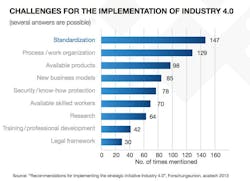There’s been quite a lot written recently about Industry 4.0 as an initiative to take the manufacturing industry forward through a complete digitization of the manufacturing process. And it’s happening at a time when the use of advancing technologies and concepts such as cloud computing, big data and the Internet of Things are driving the prospect of significant potential upswings for manufacturing-driven economies.
But at the core of Industry 4.0 and all the related concepts mentioned above is the need for interoperability—of devices, software, and entire systems.
“Industry 4.0 requires distributed intelligent systems, physical systems and virtual digital data to merge into cyber physical systems,” says Tom Burke, OPC Foundation president and executive director. “These cyber physical systems are networked to form smart objects that can be assembled into smart factories. With increasing processing power and communication capacity, production units are able to organize themselves and become self-contained. They have all the information they need or can obtain it independently. The systems are networked and autonomous, they reconfigure and optimize themselves and are expandable without engineering intervention or manual installation. Virtual images are carried throughout the production, product lifetime and value creation chain within the produced goods and always represent the current state of the actual product. Such smart products are networked with each other in the Internet of Things and respond to internal and external events with learned behavior patterns.”
The interoperability of devices and systems required to make any of this possible is what groups like the OPC Foundation focus on. Their efforts to standardize interoperability are not new, but they are finding themselves increasingly at the center of the conversation as industry starts to look at the future possibilities of Industry 4.0 and the Internet of Things more seriously.
An example of where the rubber meets the road in the here and now with OPC UA is in the intersection of IT and automation.
“The interaction between IT and the world of automation is based on the long-established model of the automation pyramid—the upper level initiates a data communication (as a client) with the level below, which responds (as a server) cyclically or on an event-driven basis,” says Stefan Hoppe, TwinCAT product manager at Beckhoff Automation and president of the OPC Foundation Europe. “With Industry 4.0, this strict separation of the levels and the top-down approach of the information flow will start to soften and mix—meaning that in an intelligent network each device or service can autonomously initiate a communication with other services.”
To facilitate this, PLCopen (an association of IEC 61131-3-based controller manufacturers) has collaborated with the OPC Foundation to define corresponding OPC UA client function blocks. This paves the way for a “PLC to exchange complex data structures horizontally with other controllers or vertically via an OPC UA server in an MES or ERP system to retrieve new production orders or write data to the cloud,” says Hoppe. “This enables the production line to act autonomously in combination with integrated OPC UA security—a key step towards Industry 4.0.”
Hoppe notes that the advantage of all this standardized interoperability for users is that a PLC program executed on different controllers from different manufacturers results in semantically identical access for OPC UA clients, regardless of their function. “The data structures are always identical and consistent, thereby significantly simplifying system engineering.”
This easing of device and systems interoperability is central to the Industry 4.0 and Internet of Things concepts—but run counter to the historical market strategy of many automation technology suppliers. You could always make one supplier’s device work with another supplier’s device, but not without a good deal of integration costs and headaches. That reality is changing faster today than it has at any time in the past. How this plays it in the next few years could dramatically alter the existing partnerships and alliances among automation suppliers and finally deliver the ease of interoperability that manufacturers have been requesting for decades.


